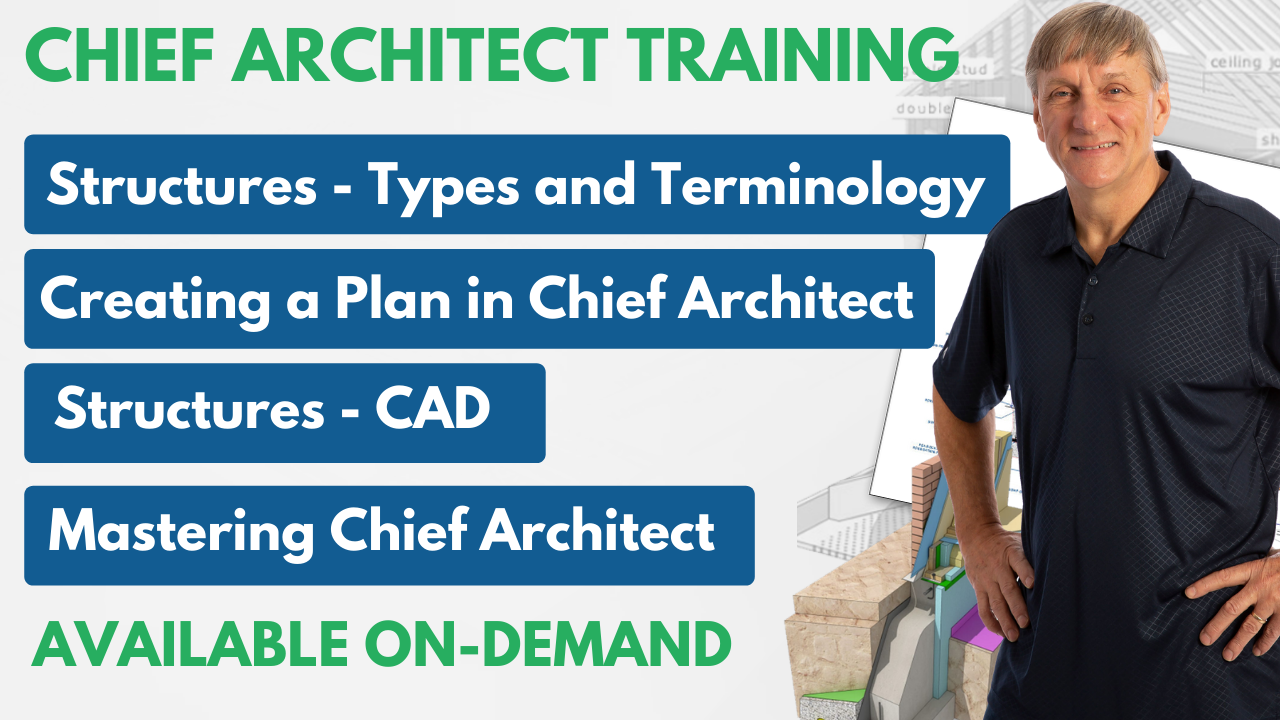Chief Experts Spin The Wheel - Designers Show #121
Feb 20, 2024
Join us for an exciting episode of The Designers Show this coming Friday where our Chief Experts will not only cover the latest trends about CAD tools, but also spin the wheel to share shortcuts about random Chief Architect icons and topics. Set your calendars for a streaming experience like no other, as we go live on Youtube and Facebook.
Show Notes
- Introduction and Greetings (00:00 - 01:09): The hosts welcome viewers to another episode, introducing themselves and mentioning attendees of the upcoming KBIS (Kitchen & Bath Industry Show) and IBS (International Builders' Show). They express excitement about the event and discuss preparations, including the number of shoes to bring.
- Discussion on Custom Shoes and Collaborative Work (01:09 - 03:00): The conversation shifts to custom shoes, highlighting one of the hosts' addiction to custom Converse. Then, they transition into discussing a collaborative kitchen design project with Western Design International, showcasing a rendering of the kitchen created in Chief Architect software. The hosts touch on the process of making materials look realistic to enhance design visualization.
- Rendering Techniques and Material Details (03:00 - 10:01): The discussion dives deeper into rendering techniques, specifically focusing on the creation of a detailed kitchen hood as an electrical symbol that projects light. The hosts talk about the use of multiple wood textures and slight hue changes to add realism to the design. They also cover the importance of material properties in achieving realistic lighting effects, with a special mention of a flooring generated using Dustin Cruz's substance player tool available on Chief Talk forums.
- Advanced Material and Lighting Techniques (10:06 - 17:22): The discussion progresses into the intricacies of using bump and normal maps to enhance the realism of floor textures. Renee demonstrates how adjusting these maps can affect the appearance of materials under different lighting conditions. He emphasizes the importance of matching the resolution of bump maps to the main texture to avoid visual inconsistencies. The hosts also touch upon the utilization of roughness maps to differentiate between gloss and matte finishes, further contributing to the realism of the rendering.
- Library Organization and Efficiency Tips (17:22 - 20:19): The conversation shifts towards strategies for organizing the Chief Architect library to streamline the design process. Renee shares his method of tagging materials and objects for easy retrieval, highlighting the use of search attributes and stacked tags to efficiently find specific items. The hosts discuss the benefits of organizing wall types and other frequently used elements in the library, as well as utilizing the "Find in Library" feature to quickly access and modify project components. This segment underscores the importance of effective library management in speeding up the design workflow and reducing time spent searching for materials and objects.
- Efficiency in Modifying Wall Properties (20:23 - 22:18): The dialogue delves into strategies for efficiently modifying wall properties, like adding thickness to interior walls and the automatic creation of new wall types based on modifications. This segment emphasizes the utility of understanding and utilizing Chief Architect's wall property adjustments for as-built versus new construction scenarios.
- Library Management and Item Selection (22:18 - 24:42): Further discussion on library management, focusing on the challenges and strategies of selecting and using items from the library. The hosts talk about the inconvenience of the default action when selecting windows and fixtures from the library and express a desire for more streamlined selection processes.
- Use of Matterport and Other Scanning Software for As-Builts (24:42 - 30:06): The conversation shifts to the use of scanning software like Matterport for creating as-builts. The hosts discuss the new features of Matterport, such as automatic dimensioning within scanned rooms, and the implications for architects and designers. They explore the potential of such technology to simplify the measurement and documentation process for existing conditions. Additionally, they touch on the importance of selecting a primary floor for dimension accuracy and the challenges of aligning walls across multiple floors.
- Use of Call Outs for Navigation and Organization (30:11 - 40:14): The hosts discuss the strategic use of call outs in Chief Architect to navigate between different parts of a plan, such as moving from floor plans to specific elevations or sections. They emphasize the importance of automatic page numbering for call outs, which updates as pages are added or rearranged, ensuring that references within the plan remain accurate.
- Automatic Page Numbering with Macros (35:07 - 37:59): The conversation delves into the technical aspects of using macros for automatic page numbering in call outs. This feature allows for dynamic updating of page numbers in the plan, ensuring that references always point to the correct page. They also touch on specific numbering systems required by some jurisdictions or for project management purposes, highlighting the flexibility of Chief Architect in accommodating various organizational methods.
- Linking Call Outs to CAD Details and Other Plan Elements (38:44 - 40:14): The hosts explore the capabilities of call outs to link to CAD details and other plan elements within Chief Architect. This functionality facilitates easy navigation between different parts of a plan and related details. They clarify that while camera call outs have specific options for plan display, typical text call outs can be used across multiple levels of a plan and linked to various elements for detailed referencing.
- Linking Call Outs to CAD Details (40:19 - 41:45): The conversation delves into how call outs can be linked to specific CAD details within Chief Architect, allowing for easy navigation between plan views and detailed drawings. The hosts demonstrate the process of linking a call out to a CAD detail and then using macros to automatically update the call out with page numbers when the details are sent to layout. This facilitates a seamless workflow where details can be easily tracked and referenced from the plan view.
- Managing Text Size in Call Outs (41:45 - 50:38): The hosts discuss their preferences for text sizes within call outs, recommending specific sizes for different parts of the call out to enhance readability and consistency across plans. They also touch on the use of macros to automate the labeling process, allowing for dynamic updating of labels based on the content of the plans or details they are associated with. This section highlights the power of Chief Architect in automating repetitive tasks and ensuring that documentation remains clear and well-organized.
- Video Cards and Chief Architect Preferences (50:44 - 54:01): The hosts discuss the importance of keeping video card drivers up to date for optimal performance with Chief Architect, specifically on PCs. They mention tools like Nvidia's GeForce Experience and AMD's Adrenaline software for managing driver updates. This is crucial for avoiding crashes and ensuring the software runs smoothly.
- Resizing Items in Chief Architect (54:01 - 55:50): A useful feature highlighted is the ability to resize items directly in the plan view using the resize button, which can be particularly handy for adjusting multiple items simultaneously for a uniform scale adjustment.
- Page Numbering in Layout Pages (55:50 - 59:30): The discussion covers the functionality within Chief Architect for automatic page numbering, utilizing macros for dynamic updates. This ensures that as pages are added or rearranged, the numbering remains accurate without manual adjustments.
- Further Exploration of Schedules (61:36 – 62:10): The hosts delve deeper into the utility of schedules in Chief Architect, particularly for windows, detailing how to use both callouts and labels to provide more information directly on the plan. They also emphasize the importance of accurately marking windows for egress and tempered glass as required by code.
- Grouping Similar Objects in Schedules (62:10 - 62:57): The discussion highlights the option to group similar objects in schedules for a more streamlined presentation, or to list each item individually for detailed tracking, depending on the project's needs. The grouping can be influenced by columns chosen for the schedule, such as floor or room labels, which can affect how items are categorized.
- Roof and Hardware Schedules (65:08 - 65:22): Mentioned briefly were the possibilities of creating schedules for roofing materials and hardware, suggesting that schedules can be a powerful tool for managing various aspects of a design beyond just windows and doors.
- Scaling Images in Schedules (65:46 - 66:24): The hosts respond to a question about scaling images within schedules, explaining how adjusting the column width can affect the size of images displayed. This can help create a balance between detail and readability in the documentation.
- Preparations for the Upcoming Summit (66:45 - End) The video concludes with reminders and excitement for the upcoming Chief Architect summit, encouraging viewers to attend for in-depth learning and networking opportunities. The hosts also mention a change in schedule for the next show due to travel plans related to the summit.



